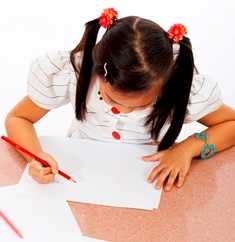 Believe it or not, the way your child holds a pencil affects their ability and willingness to do work! Many times children dislike their homework or classwork because they don’t want to write: their hands get sore and cramped and their letters and numbers are not written correctly. Teaching your child the proper way to hold a pencil is just as important as teaching them their numbers and letters.
Believe it or not, the way your child holds a pencil affects their ability and willingness to do work! Many times children dislike their homework or classwork because they don’t want to write: their hands get sore and cramped and their letters and numbers are not written correctly. Teaching your child the proper way to hold a pencil is just as important as teaching them their numbers and letters.
When Should They Know?
Children should begin to learn the proper way to hold a pencil between the ages of four and five. Before the age of 4, their hand muscles may not be fully developed, and it can cause significant damage. After 6, however, Dr. Stephanie Capshaw, a pediatric occupational therapist posits, “Pencil grip is very difficult to change... Sure, It can be done, but it will be a struggle.” Furthermore, if the proper pencil grip is not addressed early on, “it can later affect speed and legibility, as well as put undue stress on developing joints which can later cause the development of arthritis.”
The Four Grips
 When your child first picks up a crayon, chances are they will be using the Fisted Grip. They will be using their shoulder and upper arm to move the crayon. The range of motion will be limited and they will tire quickly.
When your child first picks up a crayon, chances are they will be using the Fisted Grip. They will be using their shoulder and upper arm to move the crayon. The range of motion will be limited and they will tire quickly.
As your child gets more comfortable with crayons and markers they will gradually switch the Palmer Grip. Their control over arm and hand muscles is developing. The crayon will lay across the palm and the elbow is pointed out. The shoulder muscles are steadier as your child is using more of their arm muscles to draw.
Around the age of four your child will be using the 5-Finger Grip, which is, as it sounds, a hold on the pencil using all five fingers. The wrist is usually held off the page and the wrist muscles are developing. There will be wrist movement mostly in coloring.
By the time your child is 5 they should be using the Tripod Grip. This is the grip using the thumb, pointer and middle finger. It is widely accepted as the proper pencil grip. This is when the finger muscles start to emerge as your child develops their fine motor skills.
Developing the Grip
The key to the grip is to not hold the pencil too tightly. If your child has white knuckles, or constantly is breaking the tip of the pencil, the grip is most likely too tight. To loosen their grip tell your child to imagine a small ball in their hand that they cannot squish, or wad up a small ball or paper towels to place in your child’s palm as they grip their pencil.
It is also important to help your child develop fine motor skills. They can do this by sorting a box of colored paper clips or Cheerios, one by one. You can also teach your child lacing and threading their shoes. This is a great way to develop fine motor skills and will help as they learn to trace and write their numbers and letters.
Sources
Education.com (2008). "Get a Grip on the Right Pencil Position." [Web]. Retrieved from: https://www.education.com/magazine/article/Pen_Grip/
OT Mom Learning Activities (2014). "Pencil Grasp Development." [Web]. Retrieved from: https://www.ot-mom-learning-activities.com/pencil-grasp-development.html
LeapFrog (2001). "Q: At what age should a child hold a pencil correctly?" [Web]. Retrieved from: http://www.leapfrog.com/en-us/learning-path/discussions/at-what-age-should-a-child-hold-a-pencil-correctly





